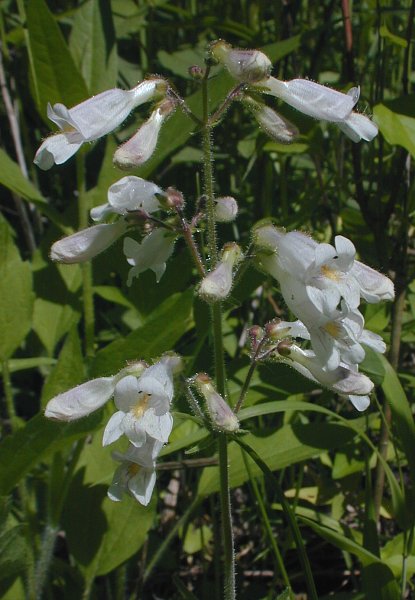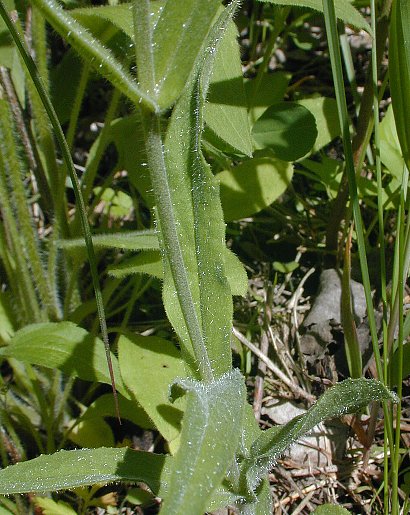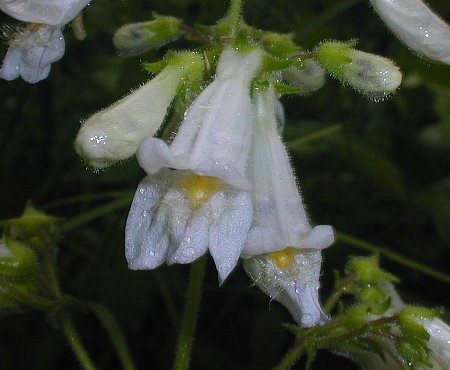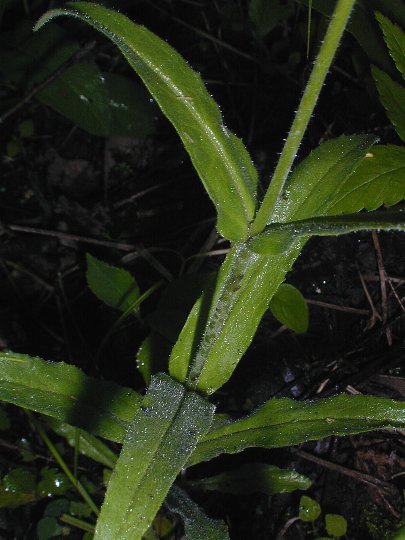Description: This perennial wildflower is 1–2½' tall and unbranched. The erect central stem is pale green and terete; it is covered with short pubescence and scattered long hairs. The opposite leaves are up to 3¼" long and ¾" across; they are linear-lanceolate or lanceolate-oblong, pale green, and entire (toothless) to slightly dentate along their margins (if teeth are present, they are small and widely spaced). Both the lower and upper surfaces of the leaves are short-pubescent. The central stem terminates in a panicle of flowers that is 4-10" long; this panicle is taller than it is wide. Individual flowers are about ¾" long, consisting of a white corolla, a short calyx with 5 teeth, 4 stamens, and a pistil with a single style. The corolla is tubular-trumpet shaped, becoming broader toward its upper and lower lips. The upper lip has 2 short rounded lobes, while the lower lip has 3 short rounded lobes. The lower lip projects outward to a greater extent than the upper lip.

Along the bottom of the corolla's interior, there are 3 faint purple veins and a pair of low ridges. Toward the throat of the corolla on the bottom, there is a narrow patch of yellow hairs. The exterior of the corolla is slightly pubescent. The calyx is light green and pubescent. The stalks of the inflorescence and pedicels of the flowers are also light green (sometimes with purplish tints) and pubescent. The blooming period occurs from mid-spring to early summer, lasting about 3 weeks for a colony of plants. There is no noticeable floral scent. Afterwards, the flowers are replaced by ovoid seed capsules about ¼" long or slightly longer. Each capsule contains numerous tiny seeds. Individual seeds are about 0.5 mm. in length or a little longer, triangular-ovoid and somewhat flattened in shape, and dark brown or black. Eventually, the capsules split in two to release their seeds; these seeds are small enough to be carried about by the wind. The root system consists of a crown with fibrous roots or a taproot.

Cultivation:
Full to
partial sun and mesic to dry conditions are preferred. Different kinds
of soil are tolerated, including those containing clay-loam, sand, or
rocky material. Reduced soil fertility is beneficial, because this
reduces competition from taller and more aggressive plants.
Range & Habitat:
The native Pale Penstemon is occasional throughout Illinois, except in
east-central
and some northern areas of the state, where it is uncommon or absent
(see Distribution
Map). Habitats include dry rocky woodlands, hill prairies,
dry-mesic railroad prairies, sandstone and limestone glades, upland
savannas, thinly wooded bluffs, rocky cliffs, and abandoned fields.
Occasional wildfires are beneficial in maintaining populations of this
species, particularly in wooded habitats.

Faunal Associations: The flowers of Pale Penstemon are cross-pollinated primarily by long-tongued bees, including honeybees, bumblebees, little carpenter bees (Ceratina spp.), and mason bees (Hoplitis spp., Osmia spp.); see Crosswhite & Crosswhite (1966) and Clinebell & Bernhardt (1998). A mason bee, Osmia distincta, is an oligolege (specialist pollinator) of Penstemon spp. These insects obtain nectar and/or pollen from the flowers. Short-tongued Halictid bees also visit the flowers for pollen. Other insects feed destructively on the foliage, flowers, or fruits of Penstemon spp. These species include the caterpillars of such moths as the Chalcedony Midget (Elaphria chalcedonia), Saunder's Sallow Moth (Sympistis saundersiana), and a stem-gall forming Gracillariid moth (Caloptilia murtfeldtella); see Covell (1984/2005), Panzer et al. (2006), and the Microleps website (2010). A polyphagous aphid, Abstrusomyzus phloxae, sucks sap from these plants (Blackman & Eastop, 2013). Generally, most mammalian herbivores appear to avoid the consumption of the foliage of these plants. For example, Georgia (1913) has stated that the foliage of Foxglove Penstemon (Penstemon digitalis) is rejected by cattle because it is unwholesome and bitter-tasting. However, Lindroth & Batzli (1984) have found that the young shoots of this same plant are readily eaten by the Meadow Vole (Microtus pennsylvanicus) in prairies.

Photographic
Location:
A small meadow at Busey Woods in Urbana, Illinois.
Comments:
Pale Penstemon is a reasonably attractive wildflower that blooms a
little earlier than other Penstemon spp. It can be
distinguished from these other species by its
evenly pubescent foliage and the following characteristics of its
corolla: 1) the lower interior surface is distinctively ridged, rather
than flat or concave, 2) the lower lip extends significantly beyond the
upper lip, and 3) the exterior is white, rather than pale rose-purple.
Overall, Pale Penstemon is more dainty in appearance than its taller
and more aggressive cousin, Foxglove Penstemon (Penstemon
digitalis). Another common name of Penstemon pallidus
is Pale Beardtongue (or
Beardstongue), which refers to the yellow hairs that line the throat of
the corolla.